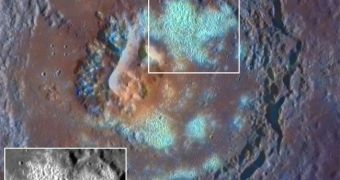In the September 30 issue of the top scientific journal Science, researchers published a series of 7 scientific papers on oddities and interesting features on the surface of the planet Mercury. The new data lead to a better understanding of the innermost planet in the solar system.
One of the papers, for example, suggests that the world is largely covered in brimstone, which is to say that the amounts of dried-up lava available could easily cover the entire state of Texas under no less than 4 miles (6.4 kilometers) of the stuff.
The vast majority of data used for this investigation were collected by the NASA MErcury Surface, Space ENvironment, GEochemistry and Ranging (MESSENGER) spacecraft, which arrived at the planet on March 18. It was launched from Earth in 2004.
It carries a comprehensive suite of scientific instruments whose goal is to gain a deeper understanding of Mercury's surface, landscape, atmosphere, core and so on, Space reports. This spacecraft is the first to achieve successful orbital insertion around the planet.
MESSENGER “is revealing that, contrary to many people's preconceptions, Mercury is a fascinating world with a complex history,” says the author of one of the studies, Johns Hopkins University Applied Physics Laboratory (JHU/APL) physicist Patrick Peplowski.
One of the interesting discoveries that the space probe made was that the smooth plains covering the northern sectors of the planet were in fact produced by unbelievably-large lava flows on the surface. In time, the molten rocks solidified, forming the smooth plains.
Brown University planetary geoscientist James Head explains that nearly 6 percent of the planetary surface is covered in solidified lava. At one point, the material was filling up craters more than 1 mile (1.6 kilometers) deep.
“When we flew by Mercury the first time with Mariner 10, we weren't really sure if volcanism caused these smooth plains. Now we're in orbit with Messenger, we're up close and personal, just going around and around and really building up our picture of Mercury,” Head explains.
Another interesting discovery made on the planet is that of shallow, rimless hollows. These structures, which have irregular shapes, also have the tendency to appear in clusters. Their presence cannot yet be explained by known natural phenomena.
JHU/APL expert David Blewett believes that sulfur-bearing compounds coming out of the ground may have led to the creation of these landscape features. Interestingly, these compounds may still be in production today.
“Analysis of the images and estimates of the rate at which the hollows may be growing leads to the exciting possibility that they are actively forming today. It is exactly this kind of unexpected discovery that makes planetary exploration such an adventure,” the expert concludes.

 14 DAY TRIAL //
14 DAY TRIAL //